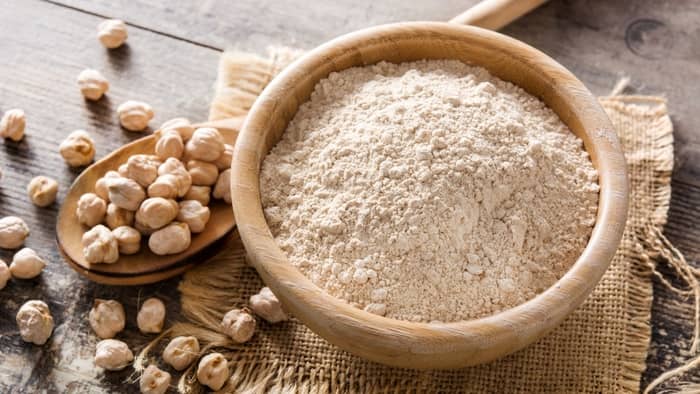Last Updated on April 20, 2022
Today, we’re going to be answering the question: is soy flour gluten free? And taking a look at the best gluten-free substitutes when it comes to soy flour. And finding out whether soy flour is really worth adding to your diet. But first, let’s take a look at what soy flour actually is.
Flour is a staple for any pantry. And of course, wheat flour is not gluten-free and unfortunately, the most common type of flour that there is. But there are plenty of other flours, including rice, amaranth, corn, chickpea, and the one we’re looking at today – soy.
What Is Soy Flour?
Soy flour is simply made from soybeans that have been ground down into a fine white powder. Soy flour is most commonly used as a thickening agent in sauces and gravies. But can also be used in baked goods such as cakes and pies. You can even use soy flour to make pasta!
Soy Flour Ingredients
The only ingredient that you’ll see in soy flour is soybeans. It would be very unusual for there to be any other ingredients in soy flour, but always check the label before purchasing.
Nutrition Of Soy Flour
The nutritional value of one cup of soy flour is as follows:
- Calories: 369
- Fat: 18g
- Protein: 32g
- Carbohydrates: 27g
- Fiber: 8g
Is Soy Flour Gluten Free?
Yes. Soy flour is considered a gluten-free flour. As long as you do not have an intolerance to soy, as well as gluten, you can add soy flour to your diet. It’s worth noting that it’s always best to buy soy flour that carries a gluten-free label, where possible. All types of flour are usually milled in the same place, so there’s a high chance of cross-contact when it comes to purchasing flour – so always be mindful of that.
Is Soybean Oil Gluten Free?
Yes. Soybean oil is simply oil that has been extracted from soybeans. And as we know, soybeans are completely gluten-free. So there is no reason why soybean oil would not be gluten-free.
Is Soy Sauce Gluten Free?
While everything else we’ve looked at today that contains soy is gluten-free, you may think this is also the case for soy sauce. However, soy sauce is not gluten-free. This is because wheat is often a primary ingredient in soy sauce. That being said, there are plenty of gluten-free soy sauces available nowadays, or you can opt for a naturally gluten-free soy sauce, such as tamari.
Learn more about: Does Soy Sauce Have Gluten? ( GF Soy Sauce Recipe)
Gluten Free Substitute For Soy Flour
If you have a separate soy allergy or are simply looking for other substitutes for soy flour, why not try one of these alternatives? They all work great in substitution for soy flour.
Almond Flour
Almond flour is becoming increasingly popular, and with its subtle nutty tones, it’s not difficult to see why. It’s one of my go-to flour choices for gluten-free baking. However, it is a slightly more expensive option, but the flavor it adds to your baking is definitely worth it!
This particular flour is very thick so you may need to add another egg to your baking, to ensure you have the right consistency. If you’re substituting soy flour for almond flour in a recipe, only use half of the required amount of almond flour, in place of the soy flour.
The nutritional value of 1oz of almond flour is:
- Calories: 163
- Fat: 14.2g
- Protein: 6.1g
- Carbohydrates: 5.6g
- Dietary Fiber: 3g
Chickpea Flour
Chickpea flour is one of the best substitutes for soy flour. This is because you can replace it in any recipe 1:1, so it requires very little effort or thought. Chickpeas are related to soy, which is why they’re such a good match for one another. Chickpea flour is ideal if you don’t want an overpowering flavor or texture change to your recipe.
The nutritional value of one cup of chickpea flour is:
- Calories: 356
- Fat: 6g
- Protein: 20g
- Carbohydrates: 53g
- Dietary Fiber: 10g

Learn more about: How To Make Chickpea Flour From Canned Chickpeas
Rice Flour
The last substitute we’re looking at is rice flour. It’s another good substitute and will achieve the same texture and flavor as soy flour. Always check the label, as sometimes rice flour is made with gluten, and therefore would not be gluten-free.
The nutritional value for one cup of rice flour is:
- Calories: 578
- Fat: 2.2g
- Protein: 9g
- Carbohydrates: 127g
- Dietary Fiber: 3.8g
If you’re looking for more gluten-free flours, I would highly recommend checking out nuts.com, which has a huge selection of gluten-free products, including flours. They have a dietary tick box chart so you can enter which dietary profiles you have. It’s super easy and really helpful.
Read more about: Does Corn Flour Have Gluten? (& GF Brands)
Conclusion
I hope this article has helped to answer the question: is soy flour gluten-free? And given you an insight into the many gluten-free flours we can, in substitution for wheat. While the gluten-free diet may seem limited at first, once you’ve grown accustomed to it – it’s much easier than you may think!
Do you know of any other gluten-free flour that didn’t make the list, that you think is worthy of a place? If so, please feel free to let me know in the comments below. Sharing is caring!
FAQs
Is Soy OK For Celiacs?
Absolutely. Soy is naturally gluten free and is safe for celiacs to consume. However, it's worth mentioning that celiacs and gluten intolerants often have other intolerances or allergies, so if you're still experiencing gluten-like symptoms after removing gluten from your diet, it may be because you have a separate issue with soy.
Is Soy Flour Bad For You?
Like most foods, if you consume too much, it can be unhealthy. But soy flour is considered good for your health, in moderation. It's a great source of protein, potassium, magnesium, phosphorus, copper and dietary fiber. Soy flour is great for building and maintaining muscle. It's the ideal substitute for wheat flour, if you're just starting out on your gluten free diet.

Hi, my name’s Zoë. I’m 28 years old and live in London, UK. I work full time as a freelance writer and critic for West End theatre. Writing has been a passion of mine for as long as I can remember. I spend most of my free time at the theatre, or at conventions. I’m married to the love of my life, and live in a small apartment with my fur baby, Lillie. I run two of my own blogs: No Safer Place and Stage to Page: both of which have won awards. I also have a YouTube channel where I talk about all things stagey.
